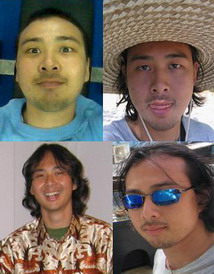Meditation - All Conditioned Things are Anicca
All conditioned things are impermanent; They arise and pass away.
To live in harmony with this truth; Brings the highest happiness.
 |
- practice to attain harmonious mind
- release negative reaction from your body, cells, molecules, till the smallest part
- be healthy and prosperous
- be calm, peaceful from within, and balance
- reach mindfulness and discernment
- sit in a meditation posture (relax your head-neck, shoulder-arms, chest-tummy-sex, both feet, buttock and back)
- pray as per your beliefs
- emanate “May All Sentient Beings be Well and Happy” from your heart to 12 directions (this exercise is effective to expand your mind in a broader level):
- entire body
- entire place we're residing in (the house, meditation center, on the plane, etc.)
- surrounding neighborhood
- upward
- downward
- frontward
- backward
- right direction
- left direction
- the earth
- the earth surrounding (solar system, milkyway, surrounding galaxies, etc.)
- the entire universe
- Concentrate in observing breath when breathing in and out and be aware of Anicca (impermanence) → FEEL the breath characteristic on each nostril: warm/cold sensation (fire element), breath length/expansion (wind element), smooth/pause (water element), heavy/light (earth element); there are 12 breath characteristics.
- FEEL the 36 body parts and 7 Chakras (while progressing, you may go back to concentrating on breathing at any time if you feel uneasy during releasing negative reaction from your physical body, indicating that your body requires more oxygen): head (+2 chakras); front neck (+chakra); right shoulder; right upper arm; right lower arm; right palm; right lower arm; right upper arm; right shoulder; base of the neck; left shoulder; left upper arm; left lower arm; left palm; left lower arm; left upper arm; left shoulder; chest (+chakra); abdominal (+chakra); sex organ (+chakra); right tight; right leg; right foot; right leg; right tight; sex area (+chakra); left tight; left leg; left foot; left leg; left tight; buttock (+base chakra); lower back; middle back; upper back; back neck.
- To focus on the pain / not healthy / sick / uneasy part of your body, FEEL the respective chakra and the area.
- To finish step 3: with your mind, wipe the entire front body from head to base, continued to back part from base to head (this is like the sensation of feeling water flowing from top to bottom of your body).
- Concentrate in observing breath during breathing in and out (no need to observe Anicca)
- Exercise to expand loving-kindness wave: "May ... be Well and Happy" (I myself, 5 closest relatives, 5 closest friends, 5 neutral persons, 5 problematic persons; and consecutively back to I myself); mention the name.
- Emit the loving-kindness aura to the entire universe
- Emit the loving-kindness aura to the loved or the deceased ones or any particular target of being
- Go back to observing breathing in and out
- Recite 3x "May All Beings be Well and Happy"
Train your mind with the lightest material (breath concentration) to make it sharper" (Ada, 2013)
Bali Usada


 To abstain from all evil
To abstain from all evil

































